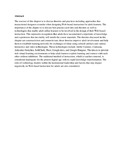Designing and Delivering Web- Based Instruction to Adult Learners in Higher Education

View/
Date
2014Author
Okojie, M C
Bourke, B
Masoumi, D
Lindström, B
Mwendia, S N
Wagacha, P W
Oboko, R
Language
enMetadata
Show full item recordAbstract
The essence of this chapter is to discuss theories and practices including approaches that instructional designers consider when designing Web-based instruction for adult learners. The importance of the chapter is to discuss best practice activities and theories as well as technologies that enable adult online learners to be involved in the design of their Web-based instruction. This represents recognition that adults have accumulated a repertoire of knowledge and experiences that inevitably will enrich the course materials. The theories discussed in this chapter are constructivism and connectivism; these theories improve adult involvement and help them to establish learning networks for exchanges of ideas using cultural artifacts and various interactive and video technologies. These technologies include Adobe Connect, Camtasia, Articulate Storyline, SoftChalk, Prezi, Google.docs, and Google Hangout. The idea is to provide rich virtual learning environments to help adult learners explore learning and connect with each other without inhibition. The traditional method of instruction, which is teacher-centered, is considered inadequate for the present digital age with its rapid knowledge transformation. The roles of technology leaders within the institutional leadership and factors that may impact negatively on Web-based instruction for adults are also considered.
Publisher
University of Nairobi
